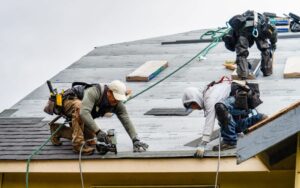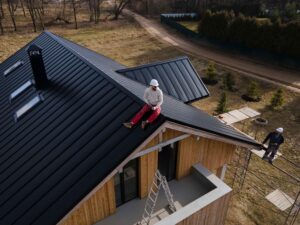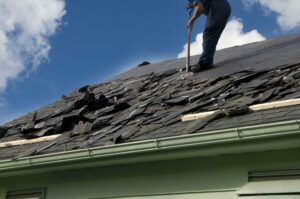Yes, you can repair a roof without replacing it, depending on the damage’s extent. Common repairs include sealing leaks, replacing missing shingles, or patching smaller issues. Regular inspections help catch problems early, preventing costly repairs later. When evaluating damage, consider the roof’s age and materials to determine repair viability. However, extensive damage may still require professional intervention. If you want to understand more about the types of repairs and when a full replacement is necessary, keep exploring further.
Common Signs Your Roof Needs Repair
When you notice water spots on your ceiling or peeling paint along the edges of your walls, it’s a clear indication that your roof may need repair. These signs often suggest underlying issues such as leaks, which can worsen if not addressed promptly. Conducting regular leak detection is essential to identify the source of moisture intrusion, especially after severe weather. The impact of weather on your roofing materials can lead to accelerated deterioration, making timely repairs vital. Look for missing shingles, sagging areas, or granule loss, as these can also signal that your roof’s integrity is compromised. By staying vigilant and proactive, you can prevent more extensive damage and maintain the longevity of your roof without resorting to a full replacement.
Types of Roof Repairs
There are several types of roof repairs you might consider based on the specific issues at hand. For instance, if you notice water stains on your ceiling, a leak repair is essential. This process often involves identifying the source of the leak, sealing it, and ensuring proper drainage to prevent future issues.
Another common repair is shingle replacement. If your roof has missing or damaged shingles, addressing this promptly can prevent further damage to the underlying structure. You’ll need to carefully remove the damaged shingles and replace them with new ones, ensuring they match the existing materials.
Assessing the Extent of Damage
Before you can decide on the best repair method, you need to assess the extent of the damage. Start with a thorough roof inspection, focusing on visible issues like missing shingles, leaks, or structural deformities. Use binoculars to check hard-to-reach areas, and don’t hesitate to climb up if it’s safe. Document any findings meticulously; this will aid in your damage assessment. Look for signs of water penetration, mold, or rot, which could indicate deeper issues. Pay attention to the age and materials of your roof, as these factors affect repair viability. By accurately gauging the damage, you can make informed decisions about whether repairs are sufficient or if further action is necessary.
DIY vs. Professional Repairs
Deciding between DIY repairs and hiring a professional can greatly impact the outcome of your roof restoration. If you’re considering DIY techniques, evaluate your skills and the complexity of the damage. Simple tasks, like patching small leaks or replacing a few shingles, may be manageable. However, guarantee you have the right materials and safety equipment to avoid further issues.
On the other hand, professional services offer expertise and efficiency, particularly for extensive damage. Experienced roofers can quickly identify underlying problems and guarantee repairs meet building codes. They often provide warranties on their work, giving you peace of mind. Ultimately, weigh your comfort level with DIY techniques against the reliability and thoroughness of professional services to make the best choice for your roof.
Cost Comparison: Repairing vs. Replacing
When weighing your options between DIY repairs and professional services, understanding the cost implications of repairing versus replacing your roof is essential. Repair costs typically range from a few hundred to several thousand dollars, depending on the extent of the damage and the materials used. In contrast, replacement costs can skyrocket, often reaching tens of thousands, particularly for larger or higher-end roofing systems. While repairs can extend the life of your roof and are generally more economical, they may not address underlying issues, leading to future expenses. Conversely, a full replacement provides a long-term solution but requires a significant upfront investment. Carefully evaluating these costs will help you make an informed decision that fits your budget and needs.
Lifespan of Different Roofing Materials
Understanding the lifespan of different roofing materials is essential for making informed decisions about repairs or replacements. Asphalt shingles typically offer a roofing lifespan of 15 to 30 years, depending on quality and climate. Metal roofs, known for their material durability, can last 40 to 70 years with proper maintenance. Tile and slate roofs boast even longer lifespans, often exceeding 50 years. Conversely, wood shingles may last around 20 to 25 years but require more upkeep. Considering these factors, you’ll be better equipped to assess whether repairs suffice or if a replacement is necessary. Ultimately, knowing the longevity of your roofing material helps you plan for future costs and maintenance needs effectively.
The Importance of Regular Maintenance
Regular maintenance is essential for extending the life of your roof and preventing costly repairs down the line. By implementing preventive measures, you can identify and address potential issues before they escalate. Start with a maintenance checklist that includes inspecting for loose or missing shingles, checking for leaks, and ensuring proper drainage. Clear debris from gutters and downspouts to prevent water accumulation, which can lead to damage. Additionally, examine the flashing around vents and chimneys for any signs of wear. Scheduling routine inspections with a professional can provide an expert assessment and further safeguard your investment. Remember, proactive care today means a more durable roof tomorrow, allowing you to avoid unexpected expenses in the future.
When to Consider a Full Roof Replacement
Although you might be tempted to patch up minor issues, there are critical signs that indicate a full roof replacement is necessary. If your roof is leaking frequently or has extensive damage, it’s time to assess full replacement factors. Age is also a major consideration; most roofs have a lifespan of 20 to 30 years, depending on the material. If your roof is approaching or surpassing this age, replacement may be more cost-effective than continual repairs. Additionally, consider the roof material; asphalt shingles might require different considerations than metal or tile. If extensive patches are needed, you may be better off investing in a new roof to guarantee long-term durability and performance.
Finding a Qualified Roofing Contractor
How do you guarantee you’re hiring a qualified roofing contractor? Start by checking for roofing certifications that indicate the contractor’s expertise and adherence to industry standards. These certifications often reflect ongoing training and knowledge of the latest roofing technologies and materials.
Next, read contractor reviews to gauge past performance and customer satisfaction. Look for feedback regarding punctuality, workmanship, and responsiveness. A contractor with consistently positive reviews is more likely to deliver quality service.
Additionally, verify the contractor is licensed and insured to protect yourself from potential liabilities. Finally, ask for references and follow up to validate their claims. By taking these steps, you can confidently hire a qualified roofing contractor for your repair needs.
Can you repair a roof without replacing it?
roof repair
roof replacement
roof repairs
roofer
roof
roofing materials
roof tiles
roofs
roofs
roofs
roofs
slate roof
asphalt shingles
shingles
shingles
shingles
shingles
shingles
shingles
shingles
shingles
shingles
shingles
shingles
shingles
shingles
shingles
shingles
fixer upper
can you repair a roof without replacing it?
roof replacement
roof replacement
roof replacement
whole roof replacement
entire roof replacement
yes, your roof can easily be repaired
roof can
roof replacements
roof replacement projects
re-roofing
re-roofing
roof system
roof damage
roof damage
roof needs
old roof
old roof
old roof
old roof
roofing solution
roof replacement costs
new roof
new roof
whole roof
entire roof
entire roof
roofing solutions
original roof
quality roof option
stable roof
quality roof
quality roof
local professional roofing
roof structure
professional roofing inspection
roof vents
good service roofer
expensive roof
energy efficient roof
roofcrafters
roofcrafters
roofcrafters
roofcrafters
roofs age
square foot roof
roofcrafters today
take- repair
new repairs
temporary repairs
few repairs
old shingles
old shingles
old shingles
repairing
repairing
repairing
repairing
repairing
repairing
repairing
repairs
new shingles
new shingles
new shingles
new shingles
repair
repair
repair
repair
repair
repair
repair
repair
repair
repair
repair
repair
repair
repair
family.at roofcrafters
individual shingles
few shingles
few shingles
damage





